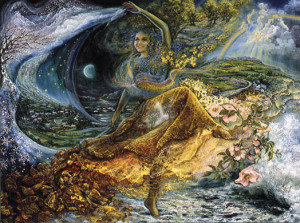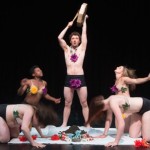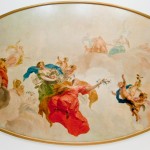Here’s my outline for our upcoming family Spring Equinox celebration:
Lord and Lady Day
Spring Equinox
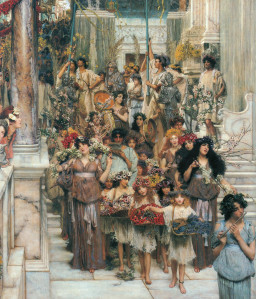
Prelude: “Freya and Frey” chant by Thorn Coyle and Sharron Knight
Hail to Freya, beauty of the North
Seer of the hidden realms within
Whose golden braids entwine the hearts of lovers
Be welcome, lusty queen of wild things
Hail to Frey, king of the Bright Ones
Whose fortune glows amber all around
Scent of pine, Keeper of the forests
Be welcome, Lord of Elves, and claim your crown
Introduction: The Wheel of the Year
Today is the spring equinox, the day when the days are the same length as the nights. From this day on, until the fall equinox, the days will be longer than the nights. This is the bright time of the year.
Many pagans call this day Ostara, which is the name of a Germanic goddess of the spring. It is also the origin of the name of the Christian holiday Easter, or “Eostre”. Some parts of the popular holiday of Easter, like eggs and the Easter Bunny, come from pagan traditions.
“This is the time of spring’s return, the joyful time, the seed time, when life bursts forth from the earth and the chains of winter are broken. It is a time of balance, when light and dark are equal, when all the elements within must be brought into new harmony. The Prince of the Sun reaches out His hand, and the Maiden Goddess returns from the dark underworlds, cloaked in fresh rain. Where they dance, wild flowers appear, despair turns to hope, sorrow turns to joy, and scarcity turns to abundance.” — Starhawk
This day is also called Lady Day in the British Isles. It is the day farmers first go out to their fields. For Pagans, this is a day for honoring not only the Goddess, but also her lover, the God. (“Why do you think that is?”) Spring is about new life and for there to be new life there usually needs to be a male and a female. The chant we heard at the beginning of our celebration was called Frey and Freya, which are the names of a Norse God and Goddess of fertility. (Do you know what fertility means?) Their names, Frey and Freya, mean “Lord” and “Lady”. So I like to call this day, Lord and Lady Day, to honor both the God and the Goddess.
In the Christian tradition, this is the season of Christ’s resurrection. All around us nature is experiencing a resurrection as well. In the pagan tradition, there are many stories of dying and rising gods and goddesses. This is the time we celebrate the triumph of the god of the sun over is dark twin and the powers of darkness. It is a time that we celebrate the return of the spring goddess from the underworld. Do you remember any stories of goddesses returning from the underworld? Do you remember Persephone? Do you remember Ishtar?
Now is the time we celebrate green life surging upward from the dark earth. Just as the Persephone returned to the arms of her mother Demeter, from the underworld where she had been kidnapped by Hades. Just as the Goddess Ishtar rose from the underworld with her son Tammuz who she had rescued from the Queen of Darkness.
The Ascent of Ishtar: Read or re-enact the story of Ishtar’s return
So Ishtar decided to make the dangerous journey to the dark Underworld. She put on the seven veils of a priestess and her seven queenly jewels and she went down to the first gate of the Underworld. Do you remember how many gates there were? And at each of the seven gates, Ishtar had to give something to the gatekeeper. In one version, he had to give up one of her seven jewels, one by one. In another version, she had to surrender one of her seven veils, one by one. In another version, she had to give him parts of her self, her soul, piece by piece until there was almost nothing left.
But when she got to the Underworld, Ishtar defeated the Queen of Death by the power of love. And she restored her lover Tammuz with water from the Well of Life. And was given freedom to return back to the land of light and life with Tammuz.
But as she started to leave, the seven judges of the underworld yelled, “Stop her! No one who enters the realm of death can return to the land of the living!” And seven dark spirits attached themselves to Ishtar and bound her with seven chains. And Ishtar was weighed down by the spirit chains.
And as she approached the seventh gate, the gate keeper confronted her and said: “Only those who have learned the first lesson of the underworld may pass.” And Ishtar answered: “I am here and the earth supports me.” And so the gatekeeper returned Ishtar’s sandals to her feet, the symbol of her ROOTEDNESS. And the dark spirit of FEAR fled from Ishtar breaking the chain. And the gatekeeper said: “You may pass”. And so on …
Continue with each gate as follows:
SIXTH GATE: “I love my body and trust its wisdom.” — return girdle [PRIDE] — dark spirit of SHAME flees — light second candle
FIFTH GATE: “I can and I will.” — return rod/brooch [POWER] — dark spirit of POWERLESSNESS/VICTIMHOOD — light third candle
FOURTH GATE: “I love and I am loved.” — return ring/brooch [JOY] — dark spirit of HATRED — light fourth candle.
THIRD GATE: “I speak the truth and my voice is heard.” — return necklace/brooch [VOICE] — dark spirit of LIES — light fifth candle
SECOND GATE: “My mind is open and I see.” — return brow-dot/circlet [VISION] — dark spirit of CLOSED-MINDEDNESS — light sixth candle
FIRST GATE: “Everything is a part of me, and I am a part of everything.” — return crown [CONNECTION] — dark spirit of DISCONNECTNESS/ALIENATION — light seventh candlea
Until at last Ishtar stood at the doorway of the horizon at dawn. And the bolt of the last gate was drawn back. And Ishtar opened the double doors of the tomb and ascended with her lover Tammuz.
Viriditas: Greenness
There once was a Christian nun who lived in the Middle Ages. Her name was Hildegaard. She was a powerful woman at a time when women did not have power. She was the leader of her own convent. And she wrote about God and about the world, at a time when many women were not taught to read or write.
Hildegaard wrote about one idea that I especially like. She had a special word for the power of God in the world: veriditas. In Latin this means “greenness”. (Why do you think she called the power of God in the world “greenness”?) Hildegaard lived in the hills in Germany in a very green part of the world, and she saw God’s power everywhere in the world around her. But it was not only in nature that Hildegaard saw “greenness”. She also saw it inside of ourselves. (Why would she call the spirit of God in us “greenness”?) She believed that the spirit of God was what made us creative and gave birth to new ideas and new possibilities inside of us. Although Hildegaard was a Christian, I think this is a very pagan idea.
In honor of Hildegaard’s idea of greenness, we are going to sing a hymn called “Rising Green”. Let me read the lyrics to you first.
Sing “Rising Green”
My blood doth rise in the roots of yon oak.
Her sap doth run in my veins.
Boundless my soul like the open sky where the stars forever have lain
Where the stars, Where the stars, where the stars forever have lain
My hands hold the weavings of time without end
My sight as deep as the sea.
Beating my heart sounds the measures of old, that of love’s eternity
That of love, that of love, that of love’s eternity
I feel the tides as they answer the moon rushing on a far distant sand
Winging my song is the wind of my breast and my love blows over the land
And my love, and my love, and my love blows over the land.
My foot carries days of old into new, our dreaming shows us the way.
Wondrous our faith settles deep in the earth, rising green to bring a new day.
Rising green, rising green, rising green to bring a new day.
Charming the Plow
Springtime was always a time of joyful celebration among ancient pagans. But it was also a time of preparation. Because what do people do in the springtime? They plant seeds. Some ancient pagans had a ritual they called “charming the plow”, in which they blessed the plow that would till the earth so that the seeds could be planted.
Today were going to charm our plows, our hoes and our spades and our shovels. We’re going to tie these ribbons on our plows. The yellow ribbons symbolize the sunlight that the seeds need to grow. The blue ribbons symbolize the rain. And the green symbolize the life inside each seed. While we do this, I’ve prepared some music with spring themes to get us in the mood: a pagan band, Daemonia Nymphe’s “Divine Goddess of Fertility”, Ennio Morricone’s “On Earth As It Is In Heaven” from the Christian-themed movie, “The Mission”, which has a spring like sound, and a famous classical composer Stravinsky’s “Rite of Spring”.
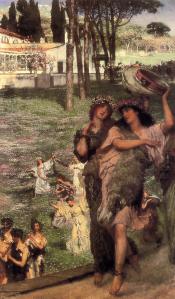
Activity
Tie brightly colored ribbons to spades and hoes while playing selection of music named above.
Benediction: Sing “Here Comes the Sun”
Here comes the sun, here comes the sun,
and I say it’s all right
Little darling, it’s been a long cold lonely winter
Little darling, it feels like years since it’s been here
Here comes the sun, here comes the sun
and I say it’s all right
Little darling, the smiles returning to the faces
Little darling, it seems like years since it’s been here
Here comes the sun, here comes the sun
and I say it’s all right
Sun, sun, sun, here it comes…
Sun, sun, sun, here it comes…
Sun, sun, sun, here it comes…
Sun, sun, sun, here it comes…
Sun, sun, sun, here it comes…
Little darling, I feel that ice is slowly melting
Little darling, it seems like years since it’s been clear
Here comes the sun, here comes the sun,
and I say it’s all right
It’s all right
Activity
Now we’re going to get our hands dirty by planting seeds in seed cups so that they can grow into shoots which we will them put in our garden. If we put them in the garden now, they will freeze with the last frost. So we’re going to grow them inside for a little while.
Plant seeds in seed cups for vegetable garden.

